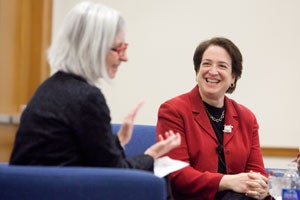When the second wave of feminism swept the country in the early 1970s, a woman had never served on the United States Supreme Court. There had never been a woman Secretary of State. If there were any women attorneys general, CEOs, or law school deans, they were rarer than water vapor on the moon. Today, there’s nothing to hold women back. Right?
Not so fast. That’s the message delivered by keynote speaker Nancy Gertner to the 300-plus attendees of the National Association of Women Judges’ (NAWJ) conference held at Harvard Law School in mid-March. Following Gertner’s lunch-time talk was a conversation between Dean Martha Minow and Associate Justice Elena Kagan of the United States Supreme Court. The two-day conference also included education sessions on courts in times of fiscal crisis, and the intersection of children and immigration issues in judicial proceedings.
Gertner (right) served for 17 years as a federal district court judge before retiring last September. She has published a memoir, “In Defense of Women: Memoirs of an Unrepentant Advocate” (Beacon Press 2011), and now teaches at Harvard Law School. In her speech to the NAWJ, Gertner questioned the conventional wisdom about progress for professional women, women lawyers in particular.
About 30 years ago, Gertner said, law schools began admitting women in numbers equal to men. Law firms began hiring women in equal numbers. But, around 1992, something got stuck. Women made it to the all-time high of around 15% of law firm equity partners—and, twenty years later, that number hasn’t budged. Why is that? And why is it not of more concern?
One theory, Gertner said, is choice. That theory holds that women aren’t being kept out of these positions; they are instead freely choosing not to pursue them, and that’s the real achievement of the women’s movement. But Gertner dismissed this explantion. “That’s not the movement I was a part of,” she said. “The movement I was a part of was about revolutionizing work and revolutionizing home.” Women are “choosing” to leave the partnership pipeline, Gertner insisted, because of social expectations and pressures, and because the workplace becomes uncomfortable for them at critical turning points in their lives. “They left because the workplace was not transformed, because the family was not transformed. It was more than the idyllic pull of motherhood on the one hand. It was the push of real obstacles in the workplace on the other,” she said.
These obstacles include the “maternal wall,” which is the assumption that motherhood renders women unable to meet the demands of the 24/7 workplace; implicit bias, which favors men in the competition for plum assignments and opportunities; and the “opacity of discrimination,” where discrimination is more contextual and less blatant than before, and is therefore hard even for women themselves to notice and identify.
The result is what Gertner called a revolution of declining expectations. Women lawyers don’t even try to get on track for the most challenging and rewarding legal careers because, someday, they may want a better work-life balance. They expect less, demand less.
What to do? Gertner didn’t present answers, but she noted where inadequacies in current law undermine women’s attempts to seek change through the courts. For example, courts look for general policies of discrimination, but these rarely exist anymore. Courts can disregard many instances of explicit discrimination because they fall into excusable legal categories. And, recent Supreme Court rulings make it easier for federal judges to dismiss plaintiffs’ complaints of discrimination. “Discrimination law is inadequate to the task of dealing with the complexity of discrimination today,” Gertner said.
Following Gertner’s keynote, Justice Kagan and Dean Martha Minow engaged in a wide-ranging conversation about the Court and Kagan’s experiences there. The discussion came back around to women’s progress when an audience member asked Kagan how many women lawyers appear before the Court each year. Not many, she said. “I think that the SG’s office bears some responsibility for this,” Kagan said, referring to the Office of the Solicitor General. Kagan was herself Solicitor General before she joined the Court. “The SG’s office is kind of the training ground for most of these lawyers, so, when the SG’s office becomes a very diverse place, then the Supreme Court bar will be a very diverse place.” The SG’s office is improving in this respect, she said. “But it could do better still.”
